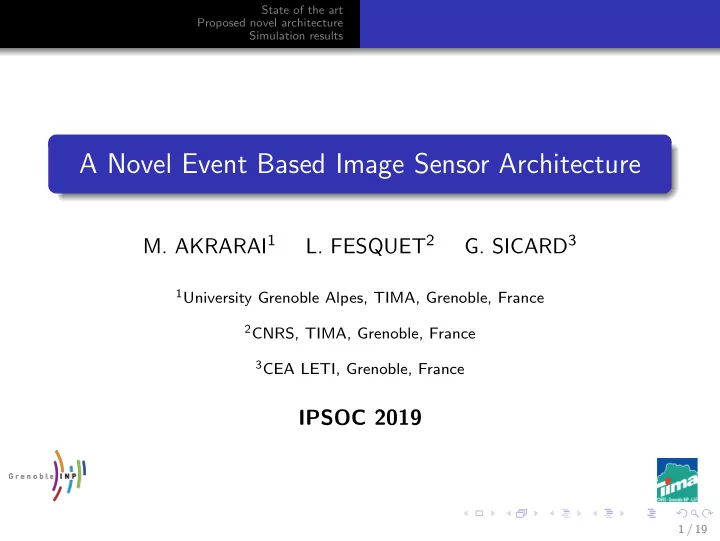

State of the art Proposed novel architecture Simulation results A Novel Event Based Image Sensor Architecture M. AKRARAI 1 L. FESQUET 2 G. SICARD 3 1 University Grenoble Alpes, TIMA, Grenoble, France 2 CNRS, TIMA, Grenoble, France 3 CEA LETI, Grenoble, France IPSOC 2019 1 / 19
State of the art Proposed novel architecture Simulation results Image Sensors Image sensors are present in various aspects of our life. Today we face the following challenges: Power consumption, increasing resolution and frame rate. The last two, increase the resources required for image and video processing, a good example is Automotive . How can we solve these engineering challenges? 2 / 19
State of the art Proposed novel architecture Simulation results Outline State of the art 1 Proposed novel architecture 2 Simulation results 3 3 / 19
State of the art Proposed novel architecture Simulation results Introduction of frameless event based image sensors and processing architectures: Compression of temporal redundancy(Tobi Delbruck [2]). Compression of spacial redundancy (Amani Darwish[1]). Event-based Object Classification (Prophesee[3]). 4 / 19
State of the art Proposed novel architecture Simulation results In both [2] and [1], the output of the image sensors is a frameless series of row and column addresses of active pixels: (a) Block schematic of the IS (b) Block schematic of the IS in (Tobi Delbruck [1]) in ( Amani Darwish [2] ) (c) Event based image sensor output 5 / 19
State of the art Proposed novel architecture Simulation results (a) Principale of a Dynamic (b) Principale of a Time to First Vision Sensor pixel in [1] Spike pixel in [2] DVS TFS 6 / 19
State of the art Proposed novel architecture Simulation results Can we combine spatial and temporal redundancies suppression and generate an event based processable output? 7 / 19
State of the art Proposed novel architecture Simulation results The combination of the two pixel (DVS, TFS) to harvest the benefits of both. The TFS will measure absolute luminance only if the DVS pixel detects a change. 8 / 19
State of the art Proposed novel architecture Simulation results (a) Architecture A (b) Architecture B (c) Architecture C depicting 1 DVS pixel depicting 1 DVS per 3 depicting 1 DVS per 5 per 1 TFS TFS TFS (d) Architecture D depicting 1 (e) Architecture E depicting 1 DVS per 8 TFS DVS per 24 TFS Figure : Suggested image sensor kernels 9 / 19
State of the art Proposed novel architecture Simulation results ... ... ... ... ... ... ... ... . . . . . . . . . . . . . . . . . . . . . . . . . . . . . . . . . . . . . . . . . . ... ... ... ... (a) Architecture A (b) Architecture B Figure : Example of pixel matrix of architecture A and B To form the image sensor matrix, the kernel is repeated until we reach the desired resolution. 10 / 19
State of the art Proposed novel architecture Simulation results Scenario Dimensions Frame rate DVS thresholds Highway 1200 × 600 30 fps 1,5,10 % Parking 1200 × 600 30 fps 1,5,10 % Worst case, will be detecting all the events from the input videos for 10 seconds: 1200 × 600 × 30 × 10 = 216000000 Events (a) Highway scenario: car on the (b) Parking scenario: a man walks in road the front of a car Figure : The two simulation scenarios 11 / 19
State of the art Proposed novel architecture Simulation results Highway scene Parking scene (a) Original highway scene (b) Original parking scene Highway.mp4 parking.mp4 (c) Simulation output video (d) Simulation output video for architecture B, 5 % DVS for architecture B, 5 % DVS threshold, Highway scenario threshold, Parking scenario 12 / 19
State of the art Proposed novel architecture Simulation results (a) Highway test case (b) Parking test case Figure : The number of generated events per architecture and DVS threshold 13 / 19
State of the art Proposed novel architecture Simulation results Figure : Comparison of architectures activity per test case for 5 % DVS threshold 14 / 19
State of the art Proposed novel architecture Simulation results Conclusion The simulation results confirm that achieving complete redundancies suppression is possible, while maintaining the relevant information of the scene. 15 / 19
State of the art Proposed novel architecture Simulation results Upcoming work One of the presented architectures will be implemented in 28 nm FDSOI technology to provide the first proof of concept. 16 / 19
State of the art Proposed novel architecture Simulation results References I ”A 128 × 128 120 dB 15 µ s Latency Asynchronous Temporal Contrast Vision Sensor” P. Lichtsteiner and C. Posch and T. Delbruck, Journal, IEEE Journal of Solid-State Circuits, 2008 A. Darwish, L. M. G. Rocha, L. Fesquet and G. Sicard, ”Design of a fully asynchronous image sensor reading system,” 2015 Conference on Design of Circuits and Integrated Systems (DCIS), Estoril, 2015, pp. 1-5. Sironi, Amos & Brambilla, Manuele & Bourdis, Nicolas & Lagorce, Xavier & Benosman, Ryad. (2018). HATS: Histograms of Averaged Time Surfaces for Robust Event-based Object Classification. 17 / 19
State of the art Proposed novel architecture Simulation results This work has been partially supported by the OCEAN12 project (H2020-EU.2.1.1.7 no78327) 18 / 19
State of the art Proposed novel architecture Simulation results THANK YOU 19 / 19
Recommend
More recommend